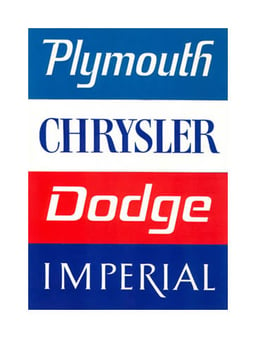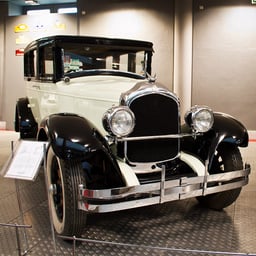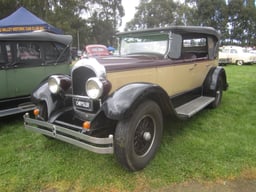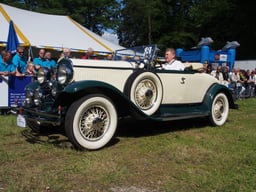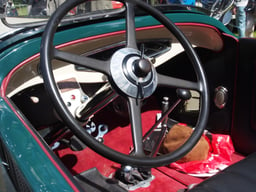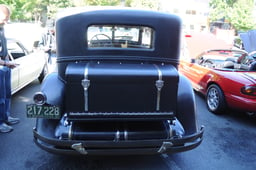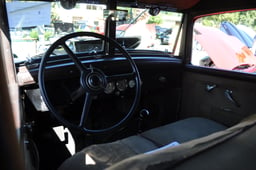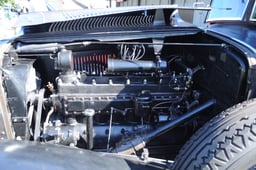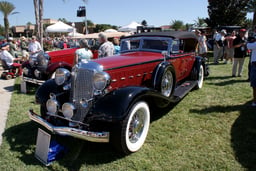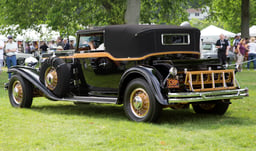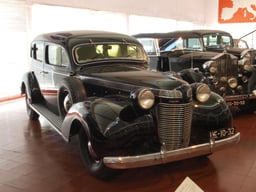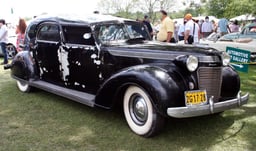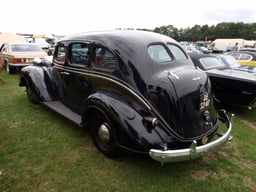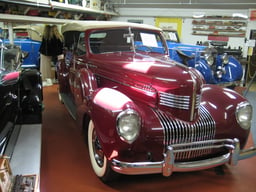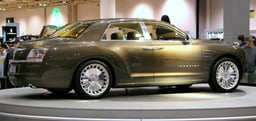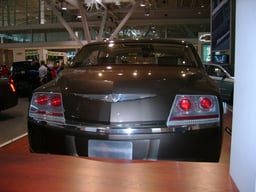Chrysler Imperial
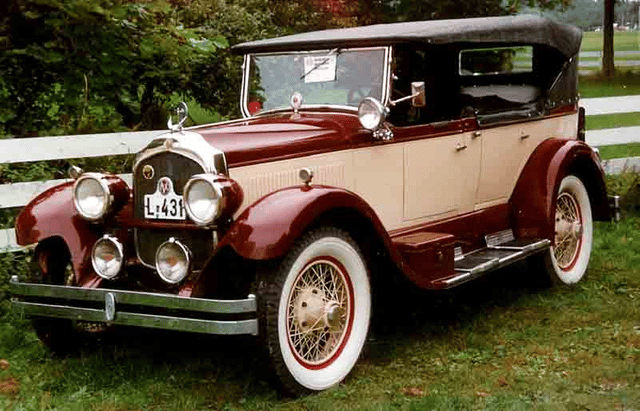
Chrysler Imperial

| Chrysler Imperial | |
|---|---|
| Overview | |
| Manufacturer | Chrysler |
| Production | 1926–1954 1989–1993 |
| Model years | 1926–1954 1990–1993 |
| Body and chassis | |
| Class | Full-size luxury car |
| Layout | FR layout (1926–1954) FF layout (1989–1993) |
| First Generation | |
 1926 Imperial Roadster | |
| Overview | |
| Production | 1926–1930 |
| Body and chassis | |
| Body style | 2-door roadster 2-door coupe 4-door sedan and phaeton Limousine |
| Layout | FR layout |
| Powertrain | |
| Engine | 288.6 cu in (4.7 L) (1926–1927)309.3 cu in (5.1 L) (1928–1930) L-head[3] 92 hp(1926–1927)[4] 100 hp(1928), 110 hp(1929–1930)I6[5] |
| Transmission | 3-speed manual 4-speed manual |
| Dimensions | |
| Wheelbase | 120 in (3,048 mm) 136 in (3,454 mm) 127 in (3,226 mm) 133 in (3,378 mm) |
| Length | 183.5 in (4,661 mm) (1926–1927[3]) |
| Second Generation | |
 1931 Chrysler Imperial LeBaron Phaeton | |
| Overview | |
| Production | 1931–1933 |
| Body and chassis | |
| Body style | 2-door roadster 2-door coupe 4-door sedan 4-door limousine |
| Layout | FR layout |
| Related | DeSoto Series K-SA Dodge Eight |
| Powertrain | |
| Engine | 384.84 cu in (6.3 L) L-head 125 hp(1932)[11] 135 hp(1933)[12] I8 |
| Transmission | Multi-range 4-speed manual[4][11] |
| Dimensions | |
| Wheelbase | 124 in (3,150 mm) (1931); Imperial 126 in (3,200 mm), Custom Imperial 146 in (3,708 mm) (1933)[4][11] |
| Length | Custom Imperial 212.5 in (5,398 mm) (1932)[11] |
| Third Generation | |
 1934 Imperial CL | |
| Overview | |
| Production | 1934–1936 |
| Body and chassis | |
| Body style | 4-door sedan |
| Layout | FR layout |
| Related | Chrysler Airflow Chrysler Airstream DeSoto Airflow DeSoto Airstream |
| Powertrain | |
| Engine | Imperial Airflow and Imperial Airflow Custom CX-323.5CID cast-iron L-head 130 hp 250lb.ft.torque Straight-8 (1934–1936); Imperial Airflow Custom CW-384.8CID cast iron L-head 150 hp CR 6.5:1 Straight-8 (1934–1936)[4] |
| Transmission | Imperial Airflow and Imperial Airflow Custom CX:3-speed manual floor-shift;[4] Imperial Airflow Custom CW:4-speed manual,[4] overdrive in 1935–1936 |
| Dimensions | |
| Wheelbase | |
| Fourth Generation | |
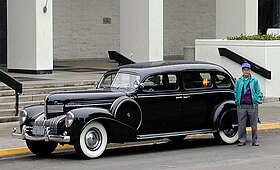 1939 C24 | |
| Overview | |
| Production | 1937–1939 |
| Body and chassis | |
| Body style | 4-door, 7-seater limousine |
| Layout | FR layout |
| Related | Chrysler Saratoga Chrysler Royal |
| Powertrain | |
| Engine | 323.5 cu in (5.3 L) Chrysler Flathead engine 130 hp (1937)[14] 140 hp(1941–1942[4]) |
| Transmission | 3-speed synchromesh manual[4] Fluid Drive |
| Dimensions | |
| Wheelbase | 144 in (3,658 mm) |
| Length | 1937 204.75 in (5,201 mm) (Imperial) 223.25 in (5,671 mm) (Imperial Custom)[4] |
| Curb weight | 3,450–3,835 lb (1,565–1,740 kg)(1938)[4] |
| Fifth Generation | |
 1948 Crown Imperial Limousine | |
| Overview | |
| Production | 1940–1948 |
| Body and chassis | |
| Body style | 4-door sedan 4-door limousine |
| Layout | FR layout |
| Related | Chrysler Saratoga Chrysler New Yorker Chrysler Windsor |
| Powertrain | |
| Engine | 323.5CID L-head 135 hp I8[19] |
| Transmission | Fluid Drive[20] |
| Dimensions | |
| Wheelbase | 145.5 in (3,696 mm)[21] |
| Length | 1940 225.25 in (5,721 mm)[17] 235 in (5,969 mm)[21] |
| Width | 77.8 in (1,976 mm)[21] |
| Curb weight | 3,900–4,560 lb (1,769–2,068 kg)(1941)[4] |
| Sixth Generation | |
 1951 Imperial Convertible | |
| Overview | |
| Model years | 1949–1954 |
| Assembly | Detroit, Michigan, United States[23] |
| Designer | K.T. Keller |
| Body and chassis | |
| Body style | 2-door Club coupe 2-door hardtop 2-door Newport hardtop 2-door convertible 4-door sedan 4-door Imperial Custom limousine 4-door Imperial Crown sedan 4-door Imperial Crown limousine[23] |
| Layout | FR layout[23] |
| Related | Chrysler Imperial Parade Phaeton Chrysler New Yorker Chrysler Town and Country Chrysler Saratoga DeSoto Custom |
| Powertrain | |
| Engine | 324 cu in (5.3 L) Chrysler I8[23] 331 cu in (5.4 L) Hemihead V8[23][24][25] |
| Transmission | 4-speed Presto-Matic semiautomatic[23] 2-speed PowerFlite automatic[23] |
| Dimensions | |
| Wheelbase | 131.5 in (3,340 mm)[23][26] 1953–54 4-door: 133.5 in (3,391 mm) Imperial Crown : 144.5 in (3,670 mm)[23] |
| Length | Imperial and Imperial Custom: 1949: 210.0 in (5,334 mm)[23] 1950: 214.0 in (5,436 mm)[23] 1951: 212.5 in (5,398 mm)[26] 1952: 212.6 in (5,400 mm) 1953 4-door: 219.0 in (5,563 mm)[23] 1953 2-door: 217.0 in (5,512 mm) 1954 4-door: 223.8 in (5,685 mm)[23][27] 1954 2-door: 221.8 in (5,634 mm)[23] Imperial Crown : 1949: 234.8 in (5,964 mm)[23] 1950: 230.3 in (5,850 mm)[23] 1951–52: 229.5 in (5,829 mm) 1953: 231.6 in (5,883 mm) 1954: 236.4 in (6,005 mm) |
| Width | Imperial and Imperial Custom: 1949–52: 75.8 in (1,925 mm)[26] 1953: 76.8 in (1,951 mm) 1954: 77.8 in (1,976 mm) Imperial Crown: 1949–52: 80.9 in (2,055 mm) 1953: 81.9 in (2,080 mm) 1954: 82.9 in (2,106 mm) |
| Height | 4-door: 63.0 in (1,600 mm) 2-door: 64.4 in (1,636 mm) Imperial Crown: 68.8 in (1,748 mm) |
| Curb weight | 4,400–5,700 lb (1,996–2,585 kg) |
| Chronology | |
| Successor | Imperial |
| Seventh Generation | |
 1990 Chrysler Imperial | |
| Overview | |
| Production | 1989–1993 |
| Model years | 1990–1993 |
| Assembly | Belvidere, Illinois |
| Body and chassis | |
| Body style | 4-door sedan |
| Layout | FF layout |
| Platform | Y-body |
| Related | Chrysler New Yorker Fifth Avenue |
| Powertrain | |
| Engine | 3.3 L EGA V6 3.8 L EGH V6 |
| Transmission | 4-speed automatic |
| Dimensions | |
| Wheelbase | 109.6 in (2,784 mm) |
| Length | 203 in (5,156 mm) |
| Width | 68.9 in (1,750 mm) |
| Height | 55.3 in (1,405 mm) |
| Curb weight | 3,519 lb (1,596 kg) |
| Chronology | |
| Successor | Chrysler LHS |
| Chrysler Imperial Concept | |
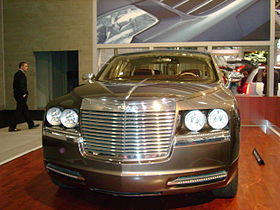 Imperial Concept exhibited in 2007 | |
| Overview | |
| Production | 2006 (Concept car) |
| Body and chassis | |
| Class | Full-size luxury car |
| Body style | 4-door sedan |
| Layout | FR layout |
| Platform | Chrysler LY platform |
| Related | Chrysler 300 |
| Dimensions | |
| Wheelbase | 123-inch (3,124 mm) |
The Chrysler Imperial, introduced in 1926, was Chrysler's top-of-the-line vehicle for much of its history. Models were produced with the Chrysler name until 1954, and again from 1990 to 1993. The company positioned the cars as a prestige marque to rival Cadillac, Continental, Lincoln, Duesenberg, Pierce Arrow, Cord, and Packard.[1] According to Antique Automobile, "The adjective ‘imperial’ according to Webster's Dictionary means sovereign, supreme, superior or of unusual size or excellence. The word imperial thus justly befits Chrysler's highest priced model."[2]
| Chrysler Imperial | |
|---|---|
| Overview | |
| Manufacturer | Chrysler |
| Production | 1926–1954 1989–1993 |
| Model years | 1926–1954 1990–1993 |
| Body and chassis | |
| Class | Full-size luxury car |
| Layout | FR layout (1926–1954) FF layout (1989–1993) |
| First Generation | |
 1926 Imperial Roadster | |
| Overview | |
| Production | 1926–1930 |
| Body and chassis | |
| Body style | 2-door roadster 2-door coupe 4-door sedan and phaeton Limousine |
| Layout | FR layout |
| Powertrain | |
| Engine | 288.6 cu in (4.7 L) (1926–1927)309.3 cu in (5.1 L) (1928–1930) L-head[3] 92 hp(1926–1927)[4] 100 hp(1928), 110 hp(1929–1930)I6[5] |
| Transmission | 3-speed manual 4-speed manual |
| Dimensions | |
| Wheelbase | 120 in (3,048 mm) 136 in (3,454 mm) 127 in (3,226 mm) 133 in (3,378 mm) |
| Length | 183.5 in (4,661 mm) (1926–1927[3]) |
| Second Generation | |
 1931 Chrysler Imperial LeBaron Phaeton | |
| Overview | |
| Production | 1931–1933 |
| Body and chassis | |
| Body style | 2-door roadster 2-door coupe 4-door sedan 4-door limousine |
| Layout | FR layout |
| Related | DeSoto Series K-SA Dodge Eight |
| Powertrain | |
| Engine | 384.84 cu in (6.3 L) L-head 125 hp(1932)[11] 135 hp(1933)[12] I8 |
| Transmission | Multi-range 4-speed manual[4][11] |
| Dimensions | |
| Wheelbase | 124 in (3,150 mm) (1931); Imperial 126 in (3,200 mm), Custom Imperial 146 in (3,708 mm) (1933)[4][11] |
| Length | Custom Imperial 212.5 in (5,398 mm) (1932)[11] |
| Third Generation | |
 1934 Imperial CL | |
| Overview | |
| Production | 1934–1936 |
| Body and chassis | |
| Body style | 4-door sedan |
| Layout | FR layout |
| Related | Chrysler Airflow Chrysler Airstream DeSoto Airflow DeSoto Airstream |
| Powertrain | |
| Engine | Imperial Airflow and Imperial Airflow Custom CX-323.5CID cast-iron L-head 130 hp 250lb.ft.torque Straight-8 (1934–1936); Imperial Airflow Custom CW-384.8CID cast iron L-head 150 hp CR 6.5:1 Straight-8 (1934–1936)[4] |
| Transmission | Imperial Airflow and Imperial Airflow Custom CX:3-speed manual floor-shift;[4] Imperial Airflow Custom CW:4-speed manual,[4] overdrive in 1935–1936 |
| Dimensions | |
| Wheelbase | |
| Fourth Generation | |
 1939 C24 | |
| Overview | |
| Production | 1937–1939 |
| Body and chassis | |
| Body style | 4-door, 7-seater limousine |
| Layout | FR layout |
| Related | Chrysler Saratoga Chrysler Royal |
| Powertrain | |
| Engine | 323.5 cu in (5.3 L) Chrysler Flathead engine 130 hp (1937)[14] 140 hp(1941–1942[4]) |
| Transmission | 3-speed synchromesh manual[4] Fluid Drive |
| Dimensions | |
| Wheelbase | 144 in (3,658 mm) |
| Length | 1937 204.75 in (5,201 mm) (Imperial) 223.25 in (5,671 mm) (Imperial Custom)[4] |
| Curb weight | 3,450–3,835 lb (1,565–1,740 kg)(1938)[4] |
| Fifth Generation | |
 1948 Crown Imperial Limousine | |
| Overview | |
| Production | 1940–1948 |
| Body and chassis | |
| Body style | 4-door sedan 4-door limousine |
| Layout | FR layout |
| Related | Chrysler Saratoga Chrysler New Yorker Chrysler Windsor |
| Powertrain | |
| Engine | 323.5CID L-head 135 hp I8[19] |
| Transmission | Fluid Drive[20] |
| Dimensions | |
| Wheelbase | 145.5 in (3,696 mm)[21] |
| Length | 1940 225.25 in (5,721 mm)[17] 235 in (5,969 mm)[21] |
| Width | 77.8 in (1,976 mm)[21] |
| Curb weight | 3,900–4,560 lb (1,769–2,068 kg)(1941)[4] |
| Sixth Generation | |
 1951 Imperial Convertible | |
| Overview | |
| Model years | 1949–1954 |
| Assembly | Detroit, Michigan, United States[23] |
| Designer | K.T. Keller |
| Body and chassis | |
| Body style | 2-door Club coupe 2-door hardtop 2-door Newport hardtop 2-door convertible 4-door sedan 4-door Imperial Custom limousine 4-door Imperial Crown sedan 4-door Imperial Crown limousine[23] |
| Layout | FR layout[23] |
| Related | Chrysler Imperial Parade Phaeton Chrysler New Yorker Chrysler Town and Country Chrysler Saratoga DeSoto Custom |
| Powertrain | |
| Engine | 324 cu in (5.3 L) Chrysler I8[23] 331 cu in (5.4 L) Hemihead V8[23][24][25] |
| Transmission | 4-speed Presto-Matic semiautomatic[23] 2-speed PowerFlite automatic[23] |
| Dimensions | |
| Wheelbase | 131.5 in (3,340 mm)[23][26] 1953–54 4-door: 133.5 in (3,391 mm) Imperial Crown : 144.5 in (3,670 mm)[23] |
| Length | Imperial and Imperial Custom: 1949: 210.0 in (5,334 mm)[23] 1950: 214.0 in (5,436 mm)[23] 1951: 212.5 in (5,398 mm)[26] 1952: 212.6 in (5,400 mm) 1953 4-door: 219.0 in (5,563 mm)[23] 1953 2-door: 217.0 in (5,512 mm) 1954 4-door: 223.8 in (5,685 mm)[23][27] 1954 2-door: 221.8 in (5,634 mm)[23] Imperial Crown : 1949: 234.8 in (5,964 mm)[23] 1950: 230.3 in (5,850 mm)[23] 1951–52: 229.5 in (5,829 mm) 1953: 231.6 in (5,883 mm) 1954: 236.4 in (6,005 mm) |
| Width | Imperial and Imperial Custom: 1949–52: 75.8 in (1,925 mm)[26] 1953: 76.8 in (1,951 mm) 1954: 77.8 in (1,976 mm) Imperial Crown: 1949–52: 80.9 in (2,055 mm) 1953: 81.9 in (2,080 mm) 1954: 82.9 in (2,106 mm) |
| Height | 4-door: 63.0 in (1,600 mm) 2-door: 64.4 in (1,636 mm) Imperial Crown: 68.8 in (1,748 mm) |
| Curb weight | 4,400–5,700 lb (1,996–2,585 kg) |
| Chronology | |
| Successor | Imperial |
| Seventh Generation | |
 1990 Chrysler Imperial | |
| Overview | |
| Production | 1989–1993 |
| Model years | 1990–1993 |
| Assembly | Belvidere, Illinois |
| Body and chassis | |
| Body style | 4-door sedan |
| Layout | FF layout |
| Platform | Y-body |
| Related | Chrysler New Yorker Fifth Avenue |
| Powertrain | |
| Engine | 3.3 L EGA V6 3.8 L EGH V6 |
| Transmission | 4-speed automatic |
| Dimensions | |
| Wheelbase | 109.6 in (2,784 mm) |
| Length | 203 in (5,156 mm) |
| Width | 68.9 in (1,750 mm) |
| Height | 55.3 in (1,405 mm) |
| Curb weight | 3,519 lb (1,596 kg) |
| Chronology | |
| Successor | Chrysler LHS |
| Chrysler Imperial Concept | |
 Imperial Concept exhibited in 2007 | |
| Overview | |
| Production | 2006 (Concept car) |
| Body and chassis | |
| Class | Full-size luxury car |
| Body style | 4-door sedan |
| Layout | FR layout |
| Platform | Chrysler LY platform |
| Related | Chrysler 300 |
| Dimensions | |
| Wheelbase | 123-inch (3,124 mm) |
1926–1930
In 1926, Walter P. Chrysler decided to compete with North American marques Cadillac, Lincoln, Packard, Pierce Arrow, Cord, and Duesenberg in the luxury car field.[6] Chrysler offered a variety of body styles: a two/four-passenger roadster (four passenger if car had the rumble seat[7]), a four-seat coupé, five-passenger sedan and phaeton, and a seven-passenger top-of-the-line limousine. The limo had a glass partition between the front and rear passenger compartments.[8]
The Imperial's new engine was slightly larger than the company's standard straight 6. It was a 288.6 cu in (4.7 L)[5] six-cylinder with seven bearing blocks and pressure lubrication of 92 brake horsepower (69 kW). Springs were semi-elliptic in the front. The car set a transcontinental speed record in the year it was introduced, driving more than 6,500 miles (10,460 km) in the week. The car was chosen as the pace car for the 1926 Indianapolis 500. The model was designated E-80, the 80 being after the "guaranteed" 80 miles per hour (129 km/h) all-day cruising speed. Acceleration was also brisk, breaking 20 seconds to 60 miles per hour (97 km/h). Four-speed transmission was added in 1930.[4] The attention to luxury and multiple bodystyles was a similar approach to one Mr. Chrysler used as president of the Buick Motor Company, his employer from 1911 to 1919.
When the second generation Imperial was introduced in 1931, the first generation was given minor updates and was called the Chrysler Six.[9] In 1920, Mr. Chrysler, who was working at the request of the bankers to make Willys profitable, had auto engineers Owen Skelton, Carl Breer, and Fred Zeder begin work on a new car for Willys, which was often referred to as the Chrysler Six.[10] When Willys encountered financial problems, Walter Chrysler and the three engineers who had been working on the Chrysler Six all moved on to Maxwell-Chalmers where they continued their work, ultimately launching the six-cylinder Chrysler in January 1924.[10] (In 1925, the Maxwell car company became the Chrysler Corporation.)
1931–1933
The Chrysler Imperial was redesigned in 1931. The car received a new 384.84-cubic inch (6308.85 cc)[12] straight-eight engine. Marketing materials for this generation of Imperial referred to the car as the "Imperial 8", in reference to the new in-line 8-cylinder engine. The engine would be found in many other Chrysler vehicles. The Imperial Custom had rust-proof fenders, automatic heater control, and safety glass.[4] The limo even came with a Dictaphone.[11]
The redesign also saw the introduction of new wire wheels that became a standard wheel treatment until the 1940s. Stock car driver Harry Hartz set numerous speed records with an Imperial sedan at Daytona Beach, Florida. It was introduced shortly after the Rolls-Royce Phantom II, Mercedes-Benz 770, Packard Eight, Duesenberg Model J, Cadillac Series 355, and Lincoln K-series appeared in the 1930s.
1934–1936

1934 Chrysler Imperial
The 1934 to 1936 Chrysler Imperial ushered in the 'Airflow' design, reflecting an interest in streamlining. The car was marketed with the slogan "The car of tomorrow is here today." It featured eight-passenger seating and again an eight-cylinder engine. It was the first car to be designed in a wind tunnel. Initial tests indicated that the standard car of the 1920s worked best in the wind-tunnel when pointed backwards with the curved rear deck facing forward. It led to a rethinking of the fundamental design of Chrysler's cars. The Airflow was an exceptionally modern and advanced car, and an unparalleled engineering success. Both engine and passenger compartment were moved forward, giving better balance and ride. An early form of unibody construction was employed, making them extremely strong. It was one of the first vehicles with fender skirts.
The public was put off by the unconventional styling and did not buy the car in large numbers. The failure of the Airflow cars in the marketplace led Chrysler to be overly conservative in their styling for the next 20 years. The "standard" styling on the lower-end Chryslers outsold the Airflow by 3 to 1. Its appearance was similar to the unrelated Tatra 77 which also appeared in the mid-1930s with a similar reaction to styling.
1937–1939
Innovations for 1937 included built-in defroster vents, safety-type interior hardware (such as flexible door handles and recessed controls on the dash[15]), seat-back padding, and fully insulated engine mounts. Brakes were 13-inch drums, then in 1939 they expanded to 14 inches,[16] but shrunk to 12-inch drums in 1940.[17] Front suspension was independent.[16]
There were three Imperial models in this generation. The C-14 was the standard eight and looked much like the Chrysler Royal C-18 with a longer hood and cowl. The C-15 was the Imperial Custom and the Town Sedan Limousine, with blind rear quarter panels. This model was available by special order. The third model, C-17, was the designation for the Airflow model. They had a concealed crank for raising the windshield and the hood was hinged at the cowl and opened from the front; side hood panels were released by catches on the inside. An Imperial Custom convertible sedan was used as an official car at the Indy 500. The car pictured is J.G. Martin's (retired airline mechanic) 1939 C-24 7-passenger limousine, believed by him and his son Tim to be the only 1939 production 7-passenger limo still on the road.
Following an assassination attempt in 1937, an armoured Chrysler Imperial was purchased as the official car for António de Oliveira Salazar, the Prime Minister of Portugal.[18]
1940–1948
In 1940 the Imperial line was reduced to Crown Imperial eight-seat sedans and divided eight-seat limousines, with the new Chrysler New Yorker taking the top model position among the standard-length models. The standard Imperial line was temporarily discontinued.[20] Two bodystyles were produced, an eight-passenger four-door sedan and an eight-passenger four-door limousine. The two vehicles had a US$100 price difference and a 10 lb (5 kg) weight difference. Hydraulic telescopic shock absorbers were in the front and rear.[22] Two-speed electric windshield wipers were standard.[21] As with all U.S.-built automobiles, production was suspended early in the 1942 model year due to World War II production demands, and did not resume until the 1946 model year.
The "Imperial" name was introduced on top-level Cadillac-built limousines, starting in 1941.
1949–1954
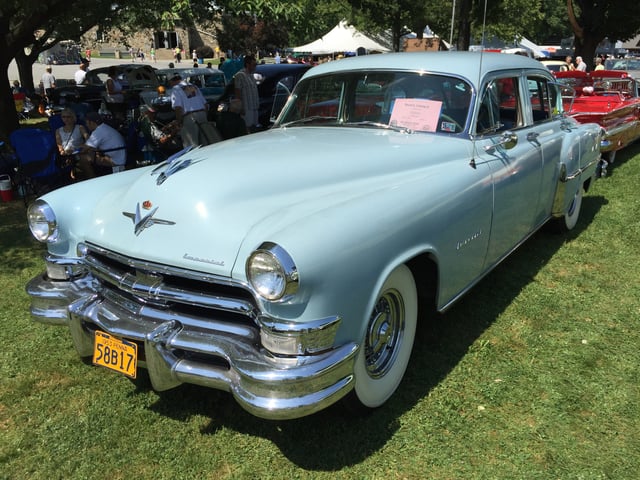
1953 Chrysler Imperial Custom limousine
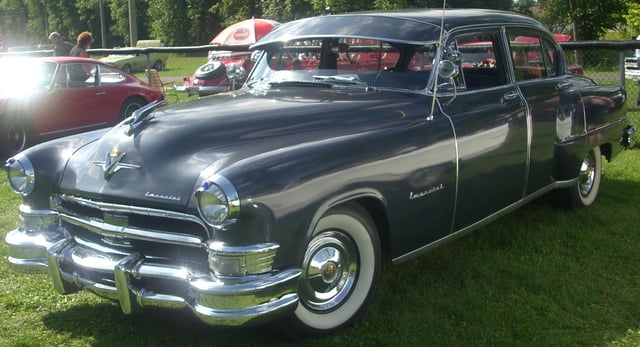
1953 Chrysler Imperial Custom
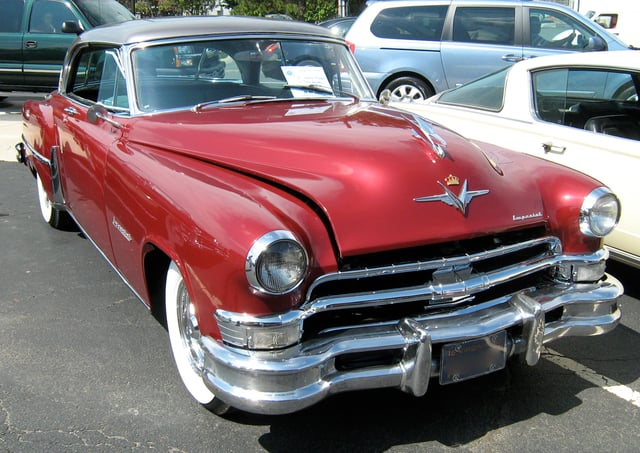
1953 Chrysler Imperial Custom coupe
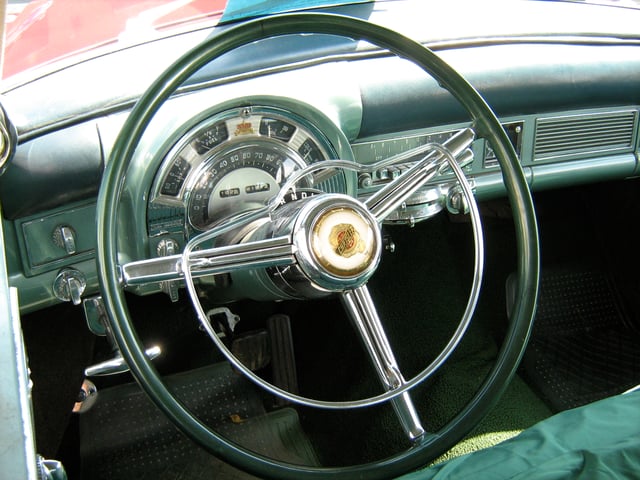
1953 Chrysler Imperial Custom coupe interior
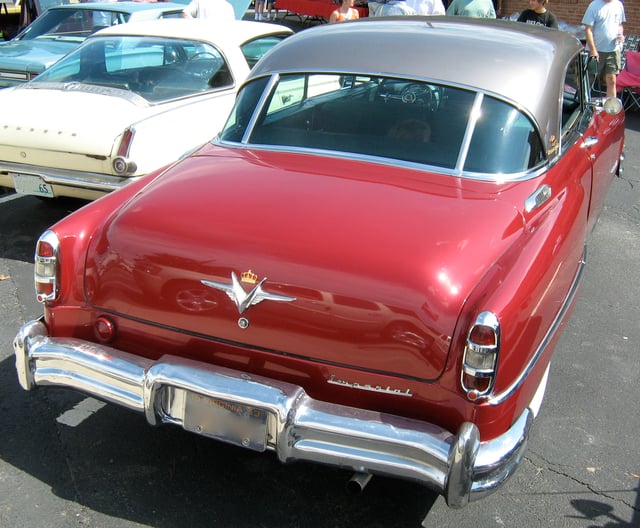
1953 Chrysler Imperial Custom coupe rear
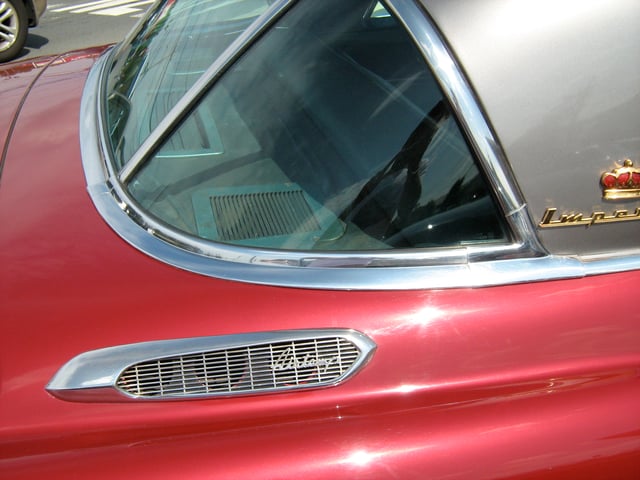
1953 Chrysler Imperial Custom coupe Airtemp air conditioning vents
Three Imperial bodystyles were produced in 1949. The short-wheelbase Imperial was only available as a four-door six-passenger sedan. The 4-door 8-passenger Crown Imperial was available as a sedan, or as a limousine with a division window.
The new custom-built Imperial sedan was based on the Chrysler New Yorker. It shared the same trim, but had a canvas-covered roof and leather and broadcloth Imperial upholstery. These features were installed by Derham, on the all new postwar Chrysler sheetmetal. Early 1949 Imperial Crowns were actually leftover 1948s. The really new models didn't arrive until March 1949. Their styling was sleeker than previous models, yet conservative. Fewer, but heavier bars were used in the cross-hatched grille. The upper and center horizontal pieces wrapped around the front fenders. Rocker panel moldings, rear fender stoneguards, full length lower-window trim, and horizontal chrome strips on the rear fenders, and from the headlights to about halfway across the front doors, were used to decorate the side body.[23]
The 1950 Crosley Hot Shot is often given credit for the first production disc brakes but the Chrysler Imperial Crown actually had them first as standard equipment at the beginning of the 1949 model year. The Crosley disc was a Goodyear development, a caliper type with ventilated rotor, originally designed for aircraft applications. Only the Hot Shot featured it. Lack of sufficient research caused enormous reliability problems, especially in regions requiring the use of salt on winter roads, such as sticking and corrosion. Drum brake conversion for Hot Shots was quite popular.[28]
The Chrysler 4-wheel disc brake system was more complex and expensive than Crosley's, but far more efficient and reliable. It was built by Auto Specialties Manufacturing Company (Ausco) of St. Joseph, Michigan, under patents of inventor H.L. Lambert, and was first tested on a 1939 Plymouth. Unlike the caliper disc, the Ausco-Lambert utilized twin expanding discs that rubbed against the inner surface of a cast iron brake drum, which doubled as the brake housing. The discs spread apart to create friction against the inner drum surface through the action of standard wheel cylinders.[28]
Chrysler discs were "self-energizing," in that some of the braking energy itself contributed to the braking effort. This was accomplished by small balls set into oval holes leading to the brake surface. When the disc made initial contact with the friction surface, the balls would be forced up the holes forcing the discs further apart and augmenting the braking energy. This made for lighter braking pressure than with calipers, avoided brake fade, promoted cooler running, and provided one-third more friction surface than standard Chrysler 12-inch (300 mm) drums. But because of the expense, the brakes were only standard on the Chrysler Imperial Crown through 1954 and the Town and Country Newport in 1950. They were optional, however, on other Chryslers, priced around $400, at a time when an entire Crosley Hot Shot retailed for $935. Today's owners consider the Ausco-Lambert very reliable and powerful, but admit its grabbiness and sensitivity.[28]
The 1950 Imperial was essentially a New Yorker with a custom interior. It had a Cadillac-style grille treatment that included circular signal lights enclosed in a wraparound ribbed chrome piece. Side trim was similar to last year's model, but the front fender strip ended at the front doors and the rear fender molding was at the tire top level and integrated into the stone guard. Unlike the standard Imperial, the Imperial Crown had a side treatment in which the rear fender moldings and stone guard were separate. Body sill moldings were used on all Imperials, but were of a less massive type on the more massive Crown models. A special version of the limousine was available. It featured a unique leather interior and a leather top that blacked out the rear quarter-windows. Power windows were standard on the Imperial Crown .[23]
In an unusual move for the 1950s, the 1951 Imperial had noticeably less chrome than the lower-priced New Yorker that was its base. It also had three horizontal grille bars with the parking lights between the bars and a chrome vertical center piece. Aside from its front fender nameplate, side body trim was limited to the moldings below the windows, rocker panel moldings, bright metal stone shields and a heavy horizontal molding strip running across the fender strips. Three 2-door bodystyles were added to the Imperial model in 1951: a Club coupe, a hardtop, and a convertible. Only 650 convertibles were sold and it would be discontinued the following year.[23] 1951 was also the year that Chrysler introduced its 331 cu in (5.4 L) Hemihead V8.[23] "Hydraguide" power steering, an industry first for use in production automobiles, became available on the Imperial for an additional $226.[29] Full-time power steering was standard on the Imperial Crown.
1952 Imperials were practically identical to the 1951 models, and the most effective way to tell the difference between them is through reference to serial numbers. The convertible bodystyle was dropped in 1952. Unlike the case with Chryslers, the Imperial's taillights were not changed. Power steering was standard. The "new" Imperial Crown was also unchanged for 1952. Only 338 of these cars were made in the 1951–1952 model run, and serial numbers indicate that 205 were registered as 1952 automobiles. A minor change was a one-inch (2.5 cm) reduction in the front tread measurement.[23]
In 1953 the Imperial model was renamed the Imperial Custom. Although the Imperial Custom resembled the New Yorker, it had a different wheelbase, taillights, and side trim. Clean front fenders and higher rear fender stone shield set it apart from the "ordinary" Chryslers. This was also the first year for the stylized eagle hood ornament. Power brakes, power windows, center folding armrests (front and rear) and a padded dash were standard. Parking lights on all Imperials were positioned between the top and center grille moldings, a variation from the design used on other Chrysler cars. A new model was the six-passenger Imperial Custom limousine which had as standard equipment electric windows, electric division window, floor level courtesy lamps, rear compartment heater, fold-up footrests, seatback mounted clock and special luxury cloth or leather interiors. On 10 March 1953, the exclusive Imperial Custom Newport hardtop was added to the Imperial line at $325 over the price of the eight-passenger sedan. The 2-door Club coupe was discontinued. Imperial Custom sedans now rode on a wheelbase 2 inches (51 mm) longer than the 2-door hardtops. The eagle ornament was about the only thing new on the 1953 Imperial Crown. The nameplate was changed slightly and the limousine featured moldings on top of the rear fenders.[23] Imperial Crowns came with a 12-volt electrical system (Imperial Customs still had a 6-volt system)[23] and Chrysler's first fully automatic transmission, called PowerFlite, became available late in the model year,[23][30] being installed in a limited number of cars for testing and evaluation. Power steering was standard on Imperial Crowns.[23] Also, 1953 was the first year that the Imperial had a one-piece windshield, instead of a two-piece one.[31] A padded dash was standard.[20]
The 1953 Chrysler Imperial was the first production car in twelve years to actually have automotive air conditioning, following tentative experiments by Packard in 1940 and Cadillac in 1941.[28] Walter P. Chrysler had seen to the invention of Airtemp air conditioning back in the 1930s for the Chrysler Building, and had ostensibly offered it on cars in 1941-42, and again in 1951-52,[23] but none are known to have been sold in the latter form until the 1953 model year. In actually installing optional Airtemp air conditioning units to its Imperials in 1953, Chrysler beat Cadillac, Buick and Oldsmobile which added air conditioning as an option in the 1953 model year.[23]
Airtemp was more sophisticated and efficient than the complicated rival air conditioners of 1953. It recirculated, rather than merely cooled, the air inside the vehicle, and it was also the highest capacity unit available on an automobile. It was also simple to operate, with a single switch on the dashboard marked with low, medium, and high positions, which the driver selected as desired. The system was capable of cooling a Chrysler from 120 degrees to 85 degrees in about two minutes, and of completely eliminating humidity, dust, pollen and tobacco smoke at the same time. Since it relied on fresh air, and drew in sixty percent more of it than any contemporary system, Airtemp avoided the staleness associated with automotive air conditioning at the time. It was silent and unobtrusive. Instead of plastic tubes mounted on the package shelf as on GM and on other cars, small ducts directed cool air toward the ceiling of the car where it filtered down around the passengers instead of blowing directly on them, a feature that modern cars have lost.[28]
In 1954 the Imperial Custom had a new grille consisting of a heavy wraparound horizontal center bar with five ridges on top and integrated circular signal lights. Its front fender nameplate was above a chrome strip, which ran the length of the front door to the front of the door opening. The rear fender stone guard was larger than in 1953, but the rocker panel molding and rear fender chrome strip style were still the same. The back-up lights were now located directly below the taillights, rather than dividing the lights as in the previous year's model. The Imperial Crown shared basic styling with the Imperial Custom. However it had center-opening rear doors and Cadillac-like rear fender taillights. Air conditioning was standard on the Imperial Crown .[23]
1955–1983: A separate make
1955-1975
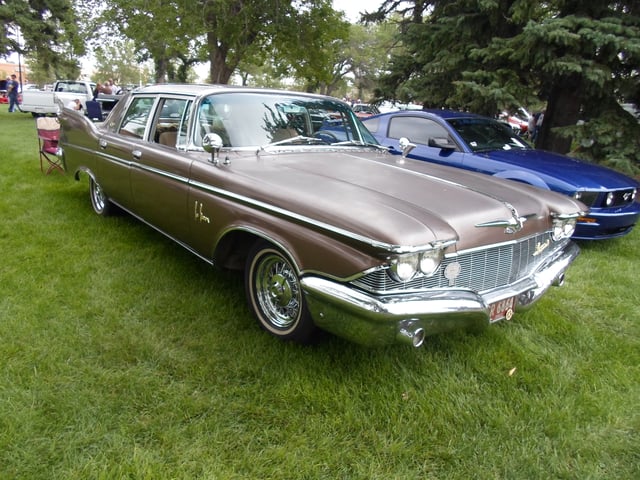
1960 Imperial LeBaron
Chrysler Corporation advised state licensing bureaus that beginning in 1955, the Imperial was to be registered as a separate make.[32] It was an attempt to compete directly with GM's Cadillac and Ford's Lincoln distinct luxury-focused marques. Frequently and erroneously referred to as the "Chrysler Imperial", these cars had no "Chrysler" badging anywhere on them until 1971 (although it was removed by 1974), and were a separate distinct marque, just as Lincoln and Cadillac were for Ford and GM. Starting with the 1974 Imperial models, the "Chrysler" badging was again removed from its car body, with only the "Imperial" nameplate appearing.
In April 1955 Chrysler and Philco announced the development and production of the world's first all-transistor car radio.[33] The radio, Mopar model 914HR, was a $150.00 "option" on 1956 Imperial automobile models. Philco began manufacturing the all-transistor car radio for Chrysler in the fall of 1955 at its Sandusky, Ohio plant.[34][35][36]
Chrysler's intention was to create an individual line of luxury cars, distinct from Chrysler branded vehicles. This marketing strategy suffered because the cars were rarely (if ever) sold in stand-alone Imperial showrooms. Cadillac and Lincoln did a much better job of separating their luxury marques from the lower priced cars that they sold. Imperial was instead offered at the Chrysler dealer network alongside Chrysler's offerings, and the marque was almost universally known as "Chrysler Imperial" in the public's mind for this reason, despite the fact that all existing dealerships did indeed carry separate "Imperial" dealership signs distinct from Chrysler .[37][38]
The Imperial automobiles continued to be retailed through Chrysler dealerships. A distinct marketing channel was not established; thus, the Imperial nameplate failed to separate itself from the other Chrysler models and become a stand-alone marque. Beginning in 1967, the Imperial Division, offering three ranges (Custom, Crown, and LeBaron), retreated from their separate body-on-frame construction and their unique body on a 129.5-inch wheelbase. From that time, Imperials used the Chrysler body. It was fitted with unique styling, and through 1973, very long hoods which accounted for the three-inch-longer (127 vs. 124") wheelbase as compared to other Chrysler sedans. They continued to use their unique front suspension with torsion bars longer than all other Chrysler products and a rubber-isolated subframe crossmember containing the torsion bar anchors, as well as full instrumentation backed up by warning lights. In 1974 and 1975, separate brochures were published and separate Imperial signs still stood above the dealerships, and the Imperial continued to feature unique features (such as hidden headlights as featured since 1969, optional antilock brakes as offered since 1971, and standard four-wheel disc brakes in both 1974 and 1975), the wheelbase was reduced to the same 124" as other big Chryslers.
Although there were no Imperials produced between 1976 and 1978, the styling that was previously used for Imperial was rebranded as the Chrysler New Yorker Brougham during this time.[39] The rear disc brakes and optional antilock feature disappeared, but the exceptionally nice interiors, including rear reading lights with precision-ground lenses which did not shine on the windshield, and four cigarette lighters, continued mostly unchanged.
1981–1983
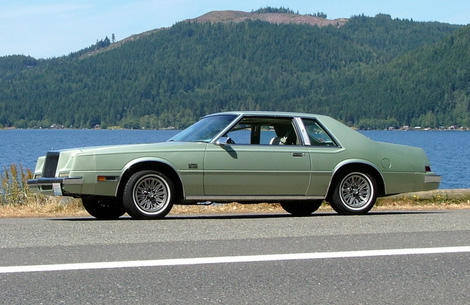
1981 Imperial
The Imperial marque was again resurrected for the model years 1981 through 1983 with a two-door coupe based on the second-generation Chrysler Cordoba platform.[40] All examples of the 1981–1983 Imperial used Chrysler's 318 cubic-inch V8 engine. All 1981 Imperials came standard with fuel injection.
1990–1993
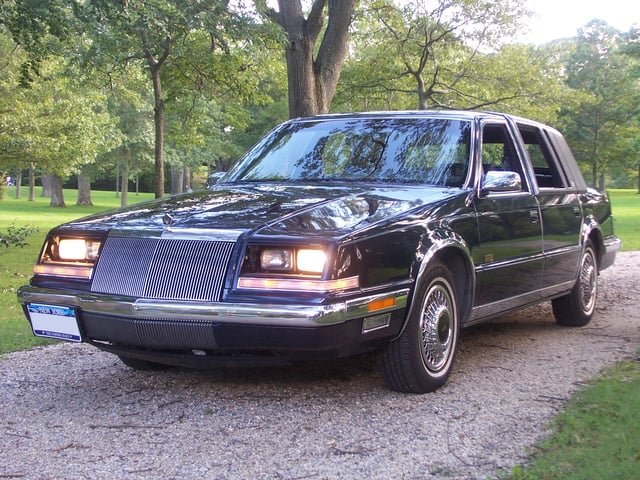
1992 Chrysler Imperial
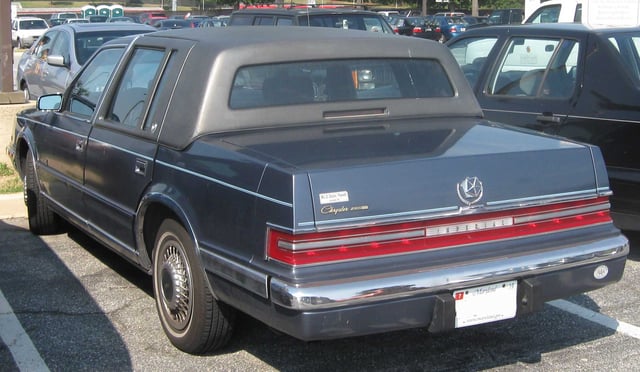
The 1990s Chrysler Imperial featured full-width taillights
The early 1990s saw a revival of the Imperial as a high-end sedan in Chrysler's lineup.[1] Unlike the 1955–1983 Imperial, this car was a model of Chrysler, not its own marque. Based on the Y platform, it represented the top full-size model in Chrysler's lineup; below it was the similar New Yorker Fifth Avenue, and below that was the shorter wheelbase New Yorker.
The reintroduction of the Imperial was two years after the Lincoln Continental was changed to a front-wheel drive sedan with a V6 engine. Other domestic competitors in this segment included the Cadillac Sedan de Ville/Fleetwood, Oldsmobile 98 and Buick Electra/Park Avenue, all of which shared General Motors' then-flagship C platform.
Though closely related, the Imperial differed from the New Yorker Fifth Avenue in many ways. The Imperial's nose was more wedge-shaped, while the New Yorker Fifth Avenue's had a sharper, more angular profile (the New Yorker Fifth Avenue was later restyled with a more rounded front end). The rears of the two cars also differed. Like the front, the New Yorker Fifth Avenue's rear came to stiffer angles while the Imperial's rear-end came to more rounded edges. Also found on the Imperial were full-width taillights which were similar to those of the Chrysler TC, as well as the early 1980s Imperial coupe, while the New Yorker Fifth Avenue came with smaller vertical taillights. On the inside, the Imperial's "Kimberly Velvet" (Mark Cross Leather was available) seats carried a more streamlined look, while the New Yorker Fifth Avenue came with its signature pillowy button-tufted seats.
Initially, the 1990 Imperial was powered by the 147 hp (110 kW) 3.3 L EGA V6 engine, which was rated at 185 lb⋅ft (251 N⋅m) of torque. For 1991, the 3.3 L V6 was replaced by the larger 3.8 L EGH V6.[41] Although horsepower only increased to 150 hp (112 kW), with the new larger 3.8 L V6 torque increased to 215 lb⋅ft (292 N⋅m) at 2750 rpm. A four-speed automatic transmission was standard with both engines.
This generation Imperial was a 6-passenger sedan offered in either velour or Mark Cross leather. Power equipment came standard, as did automatic climate controlled air conditioning, anti-lock brakes, cruise control, driver's side airbag, and its distinct landau vinyl roof. The Imperial featured hidden headlamps behind retractable metal covers similar to those found on the LeBaron coupe/convertible and New Yorker/Fifth Avenue. The Imperial was available with a choice of several Infinity sound systems, all with a cassette player. Other major options included fully electronic digital instrument cluster with information center, electronically controlled air suspension system, and remote keyless entry with security alarm. Dealer-installed integrated Chrysler cellular phones and six-disc CD changers were also available.
All seventh generation Imperials were covered by Chrysler's market-leading "Crystal Key Owner Care Program" which included a 5-year/50,000-mile limited warranty and 7-year/70,000-mile powertrain warranty. A 24-hour toll-free customer service hotline was also provided.
As originally planned, this generation Chrysler Imperial was discontinued after the 1993 model year along with the similar New Yorkers. They were replaced by the new LH platform sedans. While the New Yorker name continued on for three more years, 1993 would be the last year for Imperial. The critically acclaimed cab-forward styled Chrysler LHS replaced the Imperial as Chrysler's flagship model for 1994.
Production figures and prices
| Year | Units | Original MSRP | Today's Dollar Equivalent |
|---|---|---|---|
| 1990 | 14,968 | $25,655 | $49,199 |
| 1991 | 11,601 | $27,119 | $49,885 |
| 1992 | 7,643 | $28,453 | $50,800 |
| 1993 | 7,064 | $29,481 | $51,132 |
| Total | 41,276 | ||
2006
A Chrysler Imperial concept car was presented at the 2006 North American International Auto Show. This concept uses the Chrysler LY platform, which is an extended LX. It features a 123-inch (3,124 mm) wheelbase. Riding on 22-inch (560 mm) wheels, the car presented "a six-figure image but at a much lower price" according to Tom Tremont, Vice President of advanced vehicle design for Chrysler. The design incorporated a long hood and front end dominated by an upright radiator and a horizontal themed grille. Brushed and polished aluminum pods evoke the free-standing headlamps (a classical throwback favored by 1960s Chrysler chief designers Virgil Exner and Elwood Engel, used commonly in 1930s Chrysler vehicles). Circular LED taillights with floating outer rings harken to the "gun sight" taillight look of early 1960s Imperials. The roof line was pulled rearward to enlarge the cabin and to create a longer profile.
Cancellation
On 17 July 2007, Chrysler officially announced it would drop the production plans for the Imperial. Citing increasing fuel costs and more stringent fuel economy standards expected from Capitol Hill, Chrysler said that the Imperial project was off, as a viable business case could no longer be made for the car. The Imperial had been rumored to be based on the future Mercedes R-Class or the next generation LX-platform (LY, or a combination of components) and is suggested that all of the work done on the Imperial program will be rolled into the forthcoming LY-platform cars. These cars will include the next Chrysler 300/300C, the long-wheelbase 300/300C (Perhaps renamed New Yorker) with a much larger Imperial similar in size, but not necessarily style to the Imperial Concept of 2006.
See also
Imperial (automobile)
